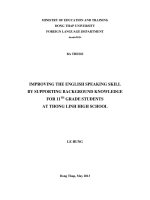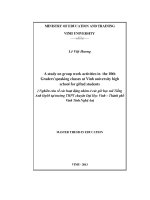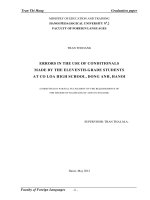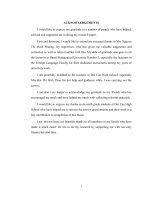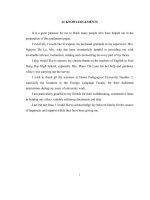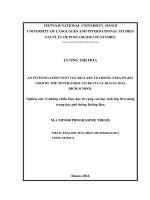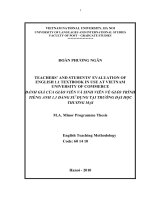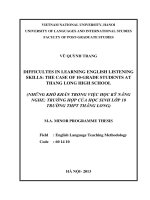Errors in the use of conditionals made by the eleventh grade students at co loa high school, dong anh, ha noi
Bạn đang xem bản rút gọn của tài liệu. Xem và tải ngay bản đầy đủ của tài liệu tại đây (496.11 KB, 83 trang )
Tran Thi Hang
Graduation paper
MINISTRY OF EDUCATION AND TRAINING
HANOI PEDAGOGICAL UNIVERSITY N0.2
FACULTY OF FOREIGN LANGUAGES
TRAN THI HANG
ERRORS IN THE USE OF CONDITIONALS
MADE BY THE ELEVENTH-GRADE STUDENTS
AT CO LOA HIGH SCHOOL, DONG ANH, HANOI
(SUBMITTED IN PARTIAL FULFILMENT OF THE REQUIREMENTS OF
THE DEGREE OF BACHELOR OF ARTS IN ENGLISH)
SUPERVISOR: TRAN THAI, M.A.
Hanoi, May 2012
Faculty of Foreign Languages
- ii -
Tran Thi Hang
Graduation paper
ACKNOWLEDGEMENTS
************
My graduation paper would not be fulfilled if there was no positive contribution
of many people in different ways.
First of all, I would like to show my greatest gratitude to Mr. Tran Thai, M.A.,
my respectful supervisor for his experienced and patient instruction, as well as his
detailed, valuable comments, suggestions and advice during my conducting the
paper.
I am delighted to acknowledge my gratitude to all the lecturers at Hanoi
Pedagogical University N02, particularly, the lecturers in the Foreign Languages
Faculty for their devoted guidance so that not only my overall insight into the
English language, but also my writing and researching skills might be enhanced.
I also wish to thank the teachers and the students at Co Loa High School,
especially Mrs. Nguyen Ngoc Anh and the two classes 11A1 and 11A4. I am
greatly indebted to all of them for their wholehearted assistance and cooperation
when I was carrying on the survey questionnaire.
Furthermore, I would like to express my sincere thanks to my close friends who
have shared with me helpful reference documents and data concerned with my
thesis.
Constantly rather than finally, I owe an enormous dept of gratitude to my beloved
family for their immeasurable support and continuous encouragement.
Faculty of Foreign Languages
- iii -
Tran Thi Hang
Graduation paper
ABSTRACT
********
The conditional sentence is one of the most significant categories in the English
language. However, due to complicated and numerous ways to form and use
conditionals, and the fact that its uses have not been fully described in textbooks,
Vietnamese high-school students of English sometimes get confused when using
this sentence type.
Students’ confusion in the use of conditionals causes them to make unexpected
errors. For this reason, an entailed paper on the subject of conditionals was
conducted to investigate high school students’ understanding of conditionals and
their ability to produce different conditional sentence types.
Based on the result of the survey, the errors in use of conditionals and the
detached causes have been found. The students had difficulties distinguishing
conditional types and choosing appropriate elements, namely verb tenses,
conjunctions, etc for each clause of conditional sentences, especially of the two
unfamiliar types: zero conditional and mixed conditionals.
Finally, following an identification of these factors, several suggested solutions
have been proposed with the hope that this type of sentences will be used more
suitably. It is advised that teachers should provide students with the knowledge of
all conditional types including their variations and their usage. For students,
practicing hard is an asset to help them deal with this sentence type and other
categories of the English language as well.
Faculty of Foreign Languages
- iv -
Tran Thi Hang
Graduation paper
STATEMENT OF AUTHORSHIP
**************
Title: Errors in the use of conditionals made by the eleventh-grade students
at Co Loa High School, Dong Anh , Hanoi
(Graduation paper submitted in partial fulfillment of
the Degree of Bachelor of Arts in English)
My passion for English has inspired me to conduct this graduation paper. I could
have sworn that the paper was resulted in my own working seriously for a period
of time. Certainly, this must not be copied from any honorable authors’ work
illegally without asking their permission.
Date submitted: May 2012
Student
Supervisor
Tran Thi Hang
Tran Thai, M.A.
Faculty of Foreign Languages
-v-
Tran Thi Hang
Graduation paper
ABBREVIATIONS
***********
EFL: English as a Foreign Language
ESL: English as a Second Language
L1: Students’ First Language
L2: Students’ Second Language
Faculty of Foreign Languages
- vi -
Tran Thi Hang
Graduation paper
TABLE OF CONTENTS
************
ACKNOWLEDGEMENTS ............................................................................ ii
ABSTRACT .................................................................................................... iii
STATEMENT OF AUTHORSHIP ............................................................... iv
ABBREVIATIONS ......................................................................................... v
TABLE OF CONTENTS ............................................................................... vi
PART ONE
INTRODUCTION
1. Rationale ...................................................................................................... 1
2. Research questions ...................................................................................... 2
3. Research aims and objectives ..................................................................... 3
4. Research scope............................................................................................. 3
5. Research methods ........................................................................................ 4
6. Significance of the proposed research ........................................................ 4
7. Design of the research work........................................................................ 5
PART TWO
DEVELOPMENT
CHAPTER ONE
THEORETICAL BACKGROUND
1.1. Literature of review in brief .................................................................... 6
1.2. Conditional sentences ............................................................................... 7
1.2.1. Definition .......................................................................................... 7
1.2.2. Forms of conditionals ........................................................................ 8
1.2.3. Types of conditionals......................................................................... 9
Faculty of Foreign Languages
- vii -
Tran Thi Hang
Graduation paper
1.2.3.1. Conditional type 0.................................................................... 10
1.2.3.1.1. Definition ......................................................................... 10
1.2.3.1.2. Form ................................................................................. 10
1.2.3.1.3. Use ................................................................................... 11
1.2.3.1.4. Variations ......................................................................... 12
1.2.3.2. Conditional type 1.................................................................... 12
1.2.3.2.1. Definition ......................................................................... 12
1.2.3.2.2. Form ................................................................................. 13
1.2.3.2.3. Use ................................................................................... 13
1.2.3.2.4. Variations ......................................................................... 14
1.2.3.3. Conditional type 2.................................................................... 16
1.2.3.3.1. Definition ......................................................................... 16
1.2.3.3.2. Form ................................................................................. 17
1.2.3.3.3. Use ................................................................................... 17
1.2.3.3.4. Variations ......................................................................... 19
1.2.3.4. Conditional type 3.................................................................... 21
1.2.3.4.1. Definition ......................................................................... 21
1.2.3.4.2. Form ................................................................................. 22
1.2.3.4.3. Use ................................................................................... 22
1.2.3.4.4. Variations ......................................................................... 23
1.2.3.5. Mixed conditionals .................................................................. 24
1.2.3.5.1. Definition ......................................................................... 24
1.2.3.5.2. Classification .................................................................... 24
1.2.3.5.2.1. Mixed third-second conditional ................................ 25
1.2.3.5.2.2. Mixed second-third conditional ................................ 26
1.2.4. Implied conditionals ......................................................................... 27
1.2.5. Other conjunctions having similar meanings to “if” .......................... 28
1.2.6. Inversion in conditionals................................................................... 32
Faculty of Foreign Languages
- viii -
Tran Thi Hang
Graduation paper
CHAPTER TWO
THE METHODOLOGY AND RESULTS
2.1 Methodology ............................................................................................ 34
2.1.1. Purpose of the survey........................................................................ 34
2.1.2. Population of the survey ................................................................... 35
2.1.3. Type of the survey ............................................................................ 35
2.1.4. Construction of the test ..................................................................... 35
2.1.5. Preparation of the survey .................................................................. 36
2.1.6. Administration of the try-out ............................................................ 37
2.1.7. Method of data analysis .................................................................... 38
2.1.8. Results of the survey ........................................................................ 38
2.2. Discussion of the results ......................................................................... 40
2.2.1. Errors in the use of conditional types ............................................... 40
2.2.2. Errors in the use of conjunctions in conditionals .............................. 44
2.2.3. Errors in the use of verb tenses in conditionals ................................ 45
2.2.4. Errors in the use of positives and negatives in conditionals ............. 47
2.2.5. Errors in the use of punctuation in conditionals .............................. 48
2.2.6. Errors in the use of inversion in conditionals ................................... 49
CHAPTER THREE
SUGGESTED SOLUTIONS AND EXERCISES
3.1. Suggested solutions ................................................................................. 51
3.1.1. For teachers ...................................................................................... 51
3.1.2. For students ...................................................................................... 53
3.2. Suggested exercises ................................................................................. 55
3.2.1. Sources of exercises ........................................................................ 55
3.2.2. Types of exercises .......................................................................... 56
3.2.3. Samples of exercises ........................................................................ 57
Faculty of Foreign Languages
- ix -
Tran Thi Hang
Graduation paper
PART THREE
CONCLUSION
1. Summary of the researching process and implications ........................... 62
2. Limitations and suggestions for further research.................................... 63
REFERENCES
APPENDIXES
Faculty of Foreign Languages
-x-
Tran Thi Hang
Graduation paper
PART ONE
INTRODUCTION
1. Rationale
Even if one does not want to, one might recognize that English grammar is really
challenging. On the way to the competence in English, students have to overcome
many obstacles. They are a system of complex categories such as reported
speech, comparatives and superlatives, relative clauses, and many types of
clauses, verbs, etc. Among these issues, conditionals are one of the most
complicated and significant to master. They are used very commonly in both
professional and personal life. To cope with this grammatical category, learners
must concern many types of conditionals structured with two clauses: if-clause
and main clause. Each of them has variations which create certain meanings for
certain contexts. Additionally, there are combinations of different tenses and a
variety of modals required to form any conditional sentences. Therefore, we need
to be knowledgeable and sensitive when using this type of sentences without
getting confused.
However intricate the conditional is, it is still an interesting category to deal with.
Surprisingly, it has not been paid much attention by any forth-year students of
Faculty of Foreign Languages at our university when they selected the subject for
their graduation papers.
Conditionals are naturally taught in secondary schools, they are re-designed in
the curriculum for high-school students to consolidate their insight on this issue.
Regrettably, there are only three main types of conditionals introduced to
students: type one, type two and type three, whereas each type of these sentences
is categorized into many different subtypes with many varied forms. Besides,
there are numerous ways to express conditions, using a variety of conjunctions,
Faculty of Foreign Languages
- xi -
Tran Thi Hang
Graduation paper
verbs except “if”. For this reason, students have missed a large part in the
immense fund of knowledge involved in conditionals. Inevitably, their challenges
when handling materials concerning all conditional types are not really easy,
especially when they are sitting for the entrance examinations into universities.
Hence, it is necessary to research the use of conditionals at high schools.
Having been studying English for several years, variations of conditionals
sometimes cause myself certain confusion, and then interest me. Thus, I have
come to the decision that this sentence type would be chosen as the topic of my
graduation paper with the hope that during my research, I could find out the
answers to the questions I have been asking myself for a long time.
Because of all subjective and objective factors mentioned above, conditionals
have surpassed other possible subjects, becoming the topic of my paper.
Hopefully, it can make certain contribution to the process of teaching and
learning English in Vietnam.
2. Research questions
Many ESL/EFL students find it difficult to solve the errors related to conditional
sentences, so do the eleventh - grade students at Co Loa High School, Dong Anh,
Hanoi. For this issue, there are several questions raised.
1. Which kind of errors do the students in grade 11 at Co Loa High School in
the academic year of 2011 – 2012 make?
2. What are the most common errors made by these students?
3. By what way can we reduce the number of such errors?
These questions have paved the way for my studying the issue.
Faculty of Foreign Languages
- xii -
Tran Thi Hang
Graduation paper
3. Research aims and objectives
The research was conducted mainly to seek the accurate answers, or at least, the
most acceptable ones to the questions put above. Firstly, the research aims at
finding out the kinds of errors that are often made by the eleventh-grade students
at Co Loa High School in the academic year of 2011 – 2012. Its second purpose
is to determine what the most general errors that these students have made are.
Next the causes of these errors must be clarified. Finally, the research is designed
to recommend useful tips to help students improve their understanding of
conditionals.
The paper needs to finish the steps as follows:
1. To study the forms of different types of conditionals with “if”, from the
basic forms to the variations.
2. To research the use of the conditional types, clarifying the meanings of
each type in each certain situation.
3. To learn about the other ways to form a conditional and their uses.
4. To carry out a survey in order that the students’ use of conditionals is
investigated, the errors will be found, and then suggested solutions to the
problems will be introduced.
4. Research scope
There is no doubt that conditional sentences are a large grammatical category. In
general, conditionals are known as sentences containing conjunction “if”.
Besides, ones formed with other conjunctions such as “providing that”,
“otherwise”, “but for”, “if only”, “even if”, etc or some verbs namely “wish”,
“hope” are also regarded as conditional patterns. However, due to the limited
scope of a graduation paper and the shortage of time, the author would like to
concentrate just on the types of conditionals structured with conjunction “if” and
Faculty of Foreign Languages
- xiii -
Tran Thi Hang
Graduation paper
the errors made by students in term of this conditional sentence type.
As mentioned, the study will be about the errors made by the eleventh-grade
students at Co Loa High School in the academic year of 2011 – 2012 with sixtytwo students attending as the population.
5. Research methods
To achieve the aims mentioned above, the research uses material collection,
quantitative and qualitative methods. Quantitative method is applied to obtain the
percentage of errors made by the students, while the qualitative one is for
analyzing their errors based on the result of the test.
6. Significance of the proposed research
To many ESL/ EFL teachers and students, it might be unfeasible to avoid making
any mistakes due to the complexity of English grammar. However, in some
specific aspects, if we find out proper solutions, we can be able to help minimize
the errors. For this reason, a graduation paper is worth being conducted with the
following expectation:
1. By synthesizing documents, the paper is hoped to help learners of English
equip quite entailed and appropriate knowledge of conditionals.
2. By pointing out the errors in students’ use of conditional sentences and
elucidating the problems, it is expected that students will avoid making
those errors again.
3. By presenting suggested solutions to the problems, the author wishes that
teachers and students will improve their methods of teaching and learning
English remarkably.
Faculty of Foreign Languages
- xiv -
Tran Thi Hang
Graduation paper
7. Design of the research work
The paper is composed of three main parts:
The first part, Introduction, offers an overall picture of the thesis.
The second part is divided into three subparts corresponding to three chapters.
1. Chapter one named Theoretical Background clarifies all the grammatical
features of conditionals including definitions, forms, uses, variations, etc.
2. Chapter two entitled The Methodology and Results reports the process in
which the survey was carried out, from determining the research purpose,
listing the methods applied, to revealing the results of the survey. In the
final point of this chapter, the findings of the research would be presented
after the survey results were analyzed.
3. Chapter three gives some suggested advices as well as exercises for both
teachers and students so that the number of errors would be minimized.
The paper comes to an end with the third part, Conclusion, References and
Appendixes.
Faculty of Foreign Languages
- xv -
Tran Thi Hang
Graduation paper
PART TWO
DEVELOPMENT
CHAPTER ONE
THEORETICAL BACKGROUND
1.1. Literature review in brief
Conditional sentences have been paid regard by many grammarians namely L. G.
Alexander (1988), John Eastwood (1994), George Yule (1998), Michael Swan
(2005), and so on. Each of them conducts their studies on conditionals,
employing different methods. However, they all consider carefully the basic
features of conditionals like a grammatical category such as definition, forms,
classification, and use.
George Yule (1998) in Explaining English Grammar gives a quite
comprehensible overview of conditional sentences: the definition, the forms, the
variations, and the uses. In his opinion, there are two main types of conditionals:
Real conditional which expressing factual or predictive relationship, and unreal
conditional which involves hypothetical and counterfactual relationship.
Furthermore, he assumes that the meanings of conditional structures are closely
pertaining to the contexts. He also pays much attention to uncertainty and
politeness in conditionals expressions.
In the book Practical English Usage, 3rd e.d., Michael Swan (2005) gives a lot of
additional information on the conditional subordinator “if”. He specially regards
the meanings created by the combination of “if” and structures with past tenses
and modals “would”, “will”, the use of if – clause in both academic and spoken English.
L. G. Alexander (1988) in Longman English Grammar focuses his attention on
three types of conditionals, their basic structures, several variations and their use.
Faculty of Foreign Languages
- xvi -
Tran Thi Hang
Graduation paper
Besides, mixed conditionals, implied conditionals, conjunctions expressing
meanings of condition, the typical features of “will” and “would” are also referred
to.
The book How English Works composed by Ann Raims (1998) is also on topic
related to conditional sentences. According to the author, there are four types of
conditionals used in the English language: real conditions of fact, real conditions
of prediction, hypothetical conditions of speculation and hypothetical conditions
of hindsight. He emphasizes that in conditions, a change in tenses might be a
signal of a change in types of the conditions rather than a change in time.
Collins Cobuild (1994) in the book “Colbuid Students’ Dictionary and
Grammar” does not name the types of conditionals, but presents the use of each
sentence type in accordance with the situation. He cautiously issues warnings in
order that students can avoid some predicable grammatical mistakes. In addition,
the author considers modals and conjunction “unless” in conditional sentences.
In brief, conditionals have been studied for ages. Several errors in the use of
conditional sentences have been mentioned in some researches, such as
Cobuild’s. However, students of English still get confused when they use this
type of sentences. Actually, there are far more errors that can be pointed out.
Hence, a more detailed study on errors in the use of conditionals should be
required to assist English learning lovers.
1.2. Conditional sentences
1.2.1. Definitions
Conditionals are defined in various ways by grammarians.
According to George Yule, a structure regarded as a conditional sentence
presents one event which is a condition for the occurrence of another event. The
Faculty of Foreign Languages
- xvii -
Tran Thi Hang
Graduation paper
previous one is typically in a clause beginning with conjunction “if”, another is
stated in a clause called the main clause. If-clause is sometimes described as the
antecedent and the main clause as the consequent. (Explaining English
Grammar, 1998: 124)
e.g. If he passes the entrance exams, his father will buy him a motorbike.
Condition: he passes the exams
Result: his father will buy him a motorbike
Another definition of conditionals is formed by Sydney Greenbaum (1996: 340)
in “The Oxford English Grammar”. Conditionals are made up by two clauses.
The conditional clause (also termed protasis) often conveys a direct condition. Its
fulfillment plays a role as the foundation of the certainty in the host clause
(termed apodosis). Occasionally, protasis may express an indirect condition.
In term of structure, it can be concluded that conditionals consist of two clauses,
if - clause (or protasis, condition clause, subordinate clause, dependent clause)
and the main clause (or apodosis, result clause, independent clause). These
clauses interrelate closely. The main clause expresses an event following another
supposed in if - clause.
1.2.2. Forms of conditionals
As mentioned above, the conditional sentence embraces two clauses. If - clause
(the condition clause) containing a condition often comes first, preceding the
main clause (the result clause) which consists of a consequence. The adverb
“then” is optional in the main clause, but is always implied. We have the
sentence structure:
Faculty of Foreign Languages
- xviii -
Tran Thi Hang
Graduation paper
Structure 1:
IF-CLAUSE
a comma
MAIN CLAUSE.
Or sometimes, the order of the two clauses can be reversed, as in the structure:
Structure 2:
IF-CLAUSE.
MAIN CLAUSE
It is not difficult to point out the difference between the two structures. In
structure 1, which is preferred, two clauses are separated by a comma, especially
when one clause is quite long.
e.g. If you promise to keep secret, (then) I will tell you the truth.
If I had known you were waiting for me, (then) I wouldn’t have chatted
with Ha so long.
However, there is no need for a comma in structure 2.
e.g. Every one would admire me if I bought a car like this.
I could ring her up if I knew her number.
The if- clause, in very limited cases, can be put at the middle of the sentence.
e.g. It may be possible, if both parties desire it, to reduce the time scale.
(Folley, M. & Hall, D. 2003: 120)
In spoken language, we often use conditionals that contain only one clause.
Sometimes, if - clause is omitted, for example:
e.g. Actually, it would be pretty difficult. (If we did as you asked)
And vice versa: e.g.:Let’s go house-riding! – O.K., if you want. (We’ll do that.)
Faculty of Foreign Languages
- xix -
Tran Thi Hang
Graduation paper
1.2.3. Types of conditionals
Grammarians have classified conditionals sentences in different ways and have
had innumerable explanations for their viewpoints. The paper, finally, follows the
way of classification given by Eastwood (1994) since it seems to be the most
obvious to deal with. According to him, conditionals are divided into 4 types:
conditional type 0, type 1, type 2, type 3. Furthermore, mixed conditionals
formed by the combination of earlier types are also listed because of the
popularity of this type in the English language.
1.2.3.1. Conditional type 0
1.2.3.1.1. Definition
Conditional type 0 or zero conditional “means that one thing always follows
automatically from another”. (Eastwood, 1994: 335). In other words, the
conditional type is used to describe general cause- effect truth, situations and
“unchanging relationships” (Hewings, 1999: 198). The condition is thought to be
either testable or observable. For example:
If you heat water 100 degree C, it boils. (Physics)
If the weather is nice on Sundays, we often go fishing. (Habit)
1.2.3.1.2. Form
Notice in the above examples, the present simple tense is applied in both
condition clause (if-clause) and result clause to indicate the certainty of
situations. We have the zero conditional structure:
If – clause
Main clause
Present simple tense
Present simple tense
Faculty of Foreign Languages
- xx -
Tran Thi Hang
Graduation paper
e.g. Wood cannot burn if it is put in fastidious environment.
If Dung encounters a difficult exercise, she often bites her nails.
1.3.1.3. Use
Conditional type 0 is often seen in academic writing to talk about scientific facts
that always have the same results.
e.g. The circle is called the unit circle if the radius is 1. (Mathematics)
If you expose phosphor to the air, it burns. (Chemistry)
If people don’t eat, they get hungry. (Biology)
Additionally, this type is used for possible future situation:
e.g. If she wins the contest this evening, she becomes the Miss.
In daily language, speakers use type 0 to mention habitual activities or rules.
e.g. If the kids have homework, they do it right after school.
The result clause can also be in a form of an imperative to give general
instruction.
e.g. If you want to operate the machine, just press the button “START”.
Sometimes, to make suggestion or permission, we use the zero conditional. Some
modals are acceptable in both clauses, particularly “can”, “may”.
e.g. If you feel tired, you can take a sleep here.
If you need somewhere to live, there’s still an empty room in our house.
(or, you can live in our house).
Faculty of Foreign Languages
- xxi -
Tran Thi Hang
Graduation paper
Note that conjunction “if” in conditionals type 0 can be replaced by other
conjunctions, namely “when”, “whenever” without changing the meaning of the
sentence.
e.g. If / When / Whenever it rains, everyone gets wet.
If / When / Whenever I see her, my heart beats uncontrollably fast.
According to (Yule, 2006: 185), conditional type 0 can express common
situations in the past. In this case, past simple tense is applied in both clauses.
e.g. They sat on the glass if it was fine.
If my grandmother went to market, she bought me some cakes.
1.2.3.1.4. Variations
Variations of a conditional type are presented by the changes of verb tenses in the
condition clause or in the result clause or in both. These changes make the
meaning of the whole sentence slightly different.
Apart from the present simple tense, we can use other present tense in the two
clauses, particularly the continuous.
E.g. If he is making a date with that girl, he is lying me.
(He said to me he loved me, but he is making a date with another girl.)
If she is studying, don’t bother her.
1.2.3.2. Conditional type 1
1.2.3.2.1. Definition
While conditional type 0 is used to talk about something generally true, type 1 is
Faculty of Foreign Languages
- xxii -
Tran Thi Hang
Graduation paper
structured for expressing prediction about a specific event in present or in the
future. The connection between the event and another possible one is considered
likely. (Yule, 2006: 185)
e.g. If he accepts to marry her, her parents will let him run the company.
If you buy this for her, she will be very happy.
1.2.3.2.2. Form
In the first conditional, the future simple tense is used in the main clause, with the most
common modal “will” and contraction “’ll”, whereas future time in the if-clause is
described in present simple tense.
If - clause
Main clause
Present simple tense
Future simple tense
e.g. I will buy a new cell phone if I receive my salary next month.
If you spend 30 minutes speaking English each day, your speaking
skill will be considerably improved.
1.2.3.2.3. Use
As mentioned, the first conditional sentence expresses the possibility of a
situation when a certain event occurs in present or in the future.
e.g. If I have time, I will go there.
Conditional type 1 is frequently used in spoken language. It can function as:
An warning
Faculty of Foreign Languages
- xxiii -
Tran Thi Hang
Graduation paper
e.g. If you hit me, I will tell that to my mum.
A threat
e.g. If you don’t pay the money, your daughter will be killed.
An offer
e.g. I’ll pick you up if you want.
An advice
e.g. If you don’t feel well, you should take a rest.
A promise
e.g. If I win the contest, I’ll give my all reward to the charity fund.
A command
e.g. If you get home early, help your mother cook the dinner.
A suggestion
e.g. Shall we go horse-riding if it is nice tomorrow?, etc.
1.2.3.2.4. Variations
1.2.3.2.4.1. Changes in form
As can be seen from the previous examples, imperatives are acceptable in the
first conditional. Imperatives are utilized in the main clause to make command,
warning, threat, etc.
e.g. If you see her, give her my love.
Faculty of Foreign Languages
- xxiv -
Tran Thi Hang
Graduation paper
Don’t try to stay up late if you feel unpleased.
1.2.3.2.4.2. Changes in modals
Modals such as “can, could, may, might, ought to, should, had better, must”,
additionally, can appear in one of the clauses or either two clauses. We use them
when we are not sure enough to use “will” or when we need to express necessity,
etc. (Alexander, 1988: 275).
e.g. If you finish your homework, you can go out.
If she cannot walk herself, you should help her.
“Should” (not “would”) used in the if-clause reduces the degree of the reality and
make the speech more polite.
e.g. If you should need to buy a car, contact us.
Although “happen to” is not a modal, the structures “if…should” and “if…happen
to”, have similar meaning. Sometimes, they can be combined.
e.g. If someone should happen to come this way, it will bring to a blind
alley.
Notice that these structures are typically used in the first conditional, not usually
in other types of conditionals.
Another modal that should be paid attention to is “will”. It is often considered
incorrect if we use “will” in if-clause to refer to future time. However, if-clause
can contain “will” to express willingness and “won’t” for refusal.
e.g. If you will come this way, I’ll show you your room. (Swan, 2005: 237)
Faculty of Foreign Languages
- xxv -
Tran Thi Hang
Graduation paper
1.2.3.2.4.3. Changes in verb tenses
As well as present simple tense, other present tenses can be used in if-clause, but
less common.
e.g. If he is standing in the rain, he will get a cold. (Alexander, 1988: 274)
If you have been staying up all night, you should have more sleep.
In addition, we can also use other future tenses in the main clause.
e.g. If you don’t rush, the plane will have taken off.
It is known that conditional type 1 is sometimes used to make threats or
warnings. Threats here are someone’s negative attention and stronger than
warnings. Therefore, “be going to” is preferred in the main clause rather than the
modal “will”.
e.g. If you don’t stop, I’m going to inform the police.
Also, it is possible to combine modals with continuous or perfect tense:
e.g. If her daughter has got scholarship, they may be celebrating tonight.
1.2.3.3. Conditional type 2
1.2.3.3.1. Definition
Conditional type 2 or the second conditional is used to express imaginary
situations and their imaginary results in the present and in the future (Baugh,
1987: 347). By comparison, conditional type 1 talks about a real situation and its
possible consequence in the same time.
e.g. If I become the President, I will not raise taxes. (A candidate’s
statement)
Faculty of Foreign Languages
- xxvi -


